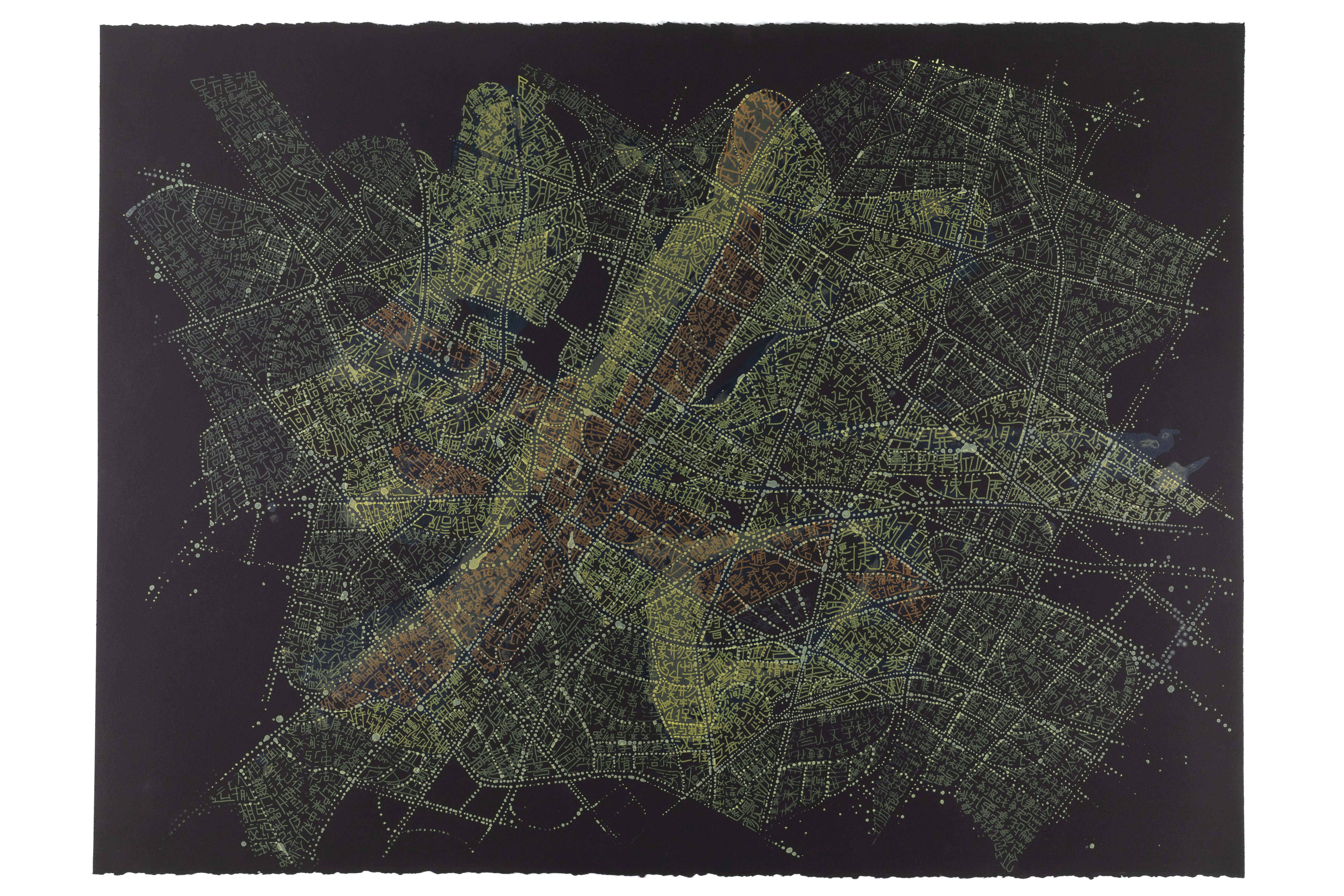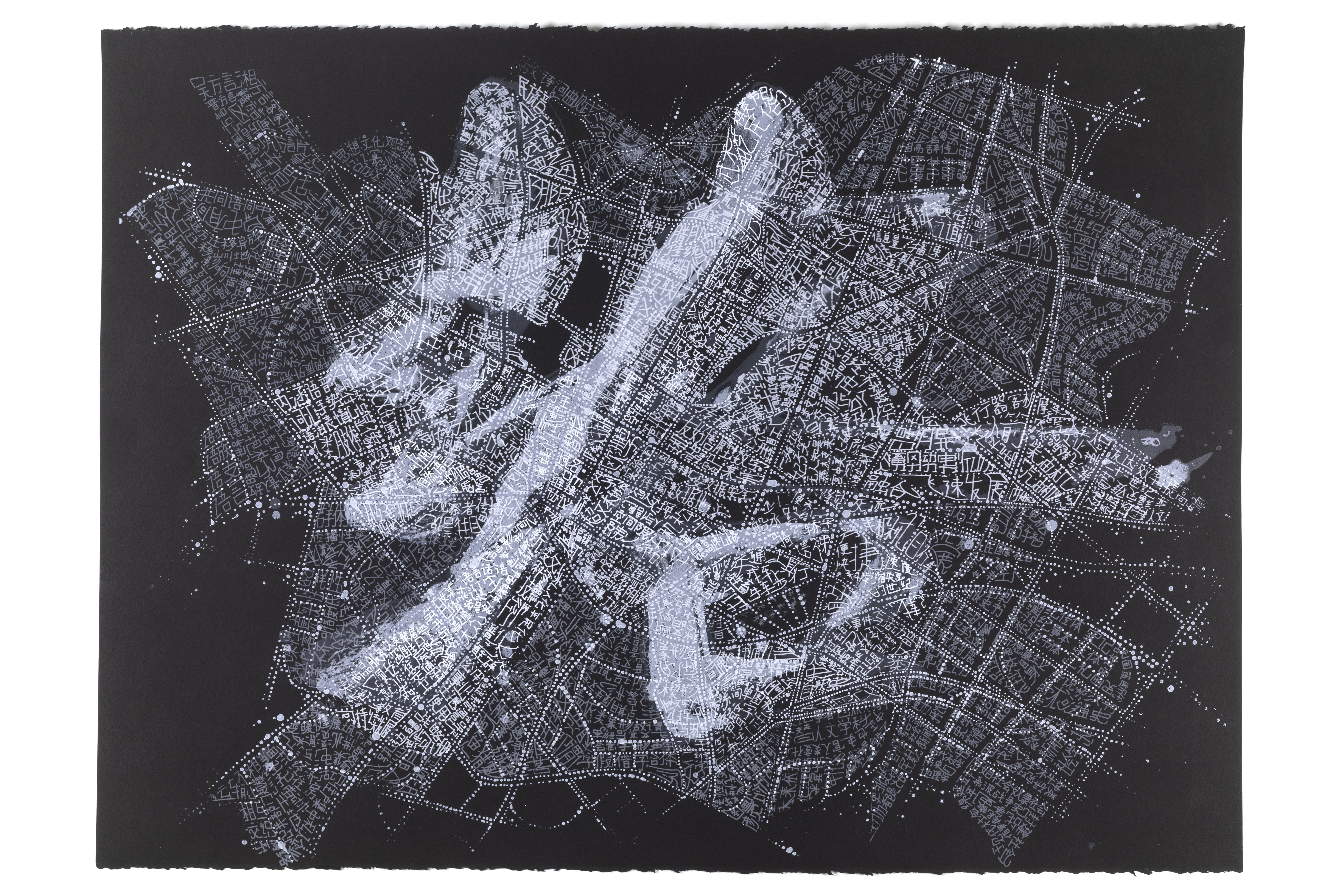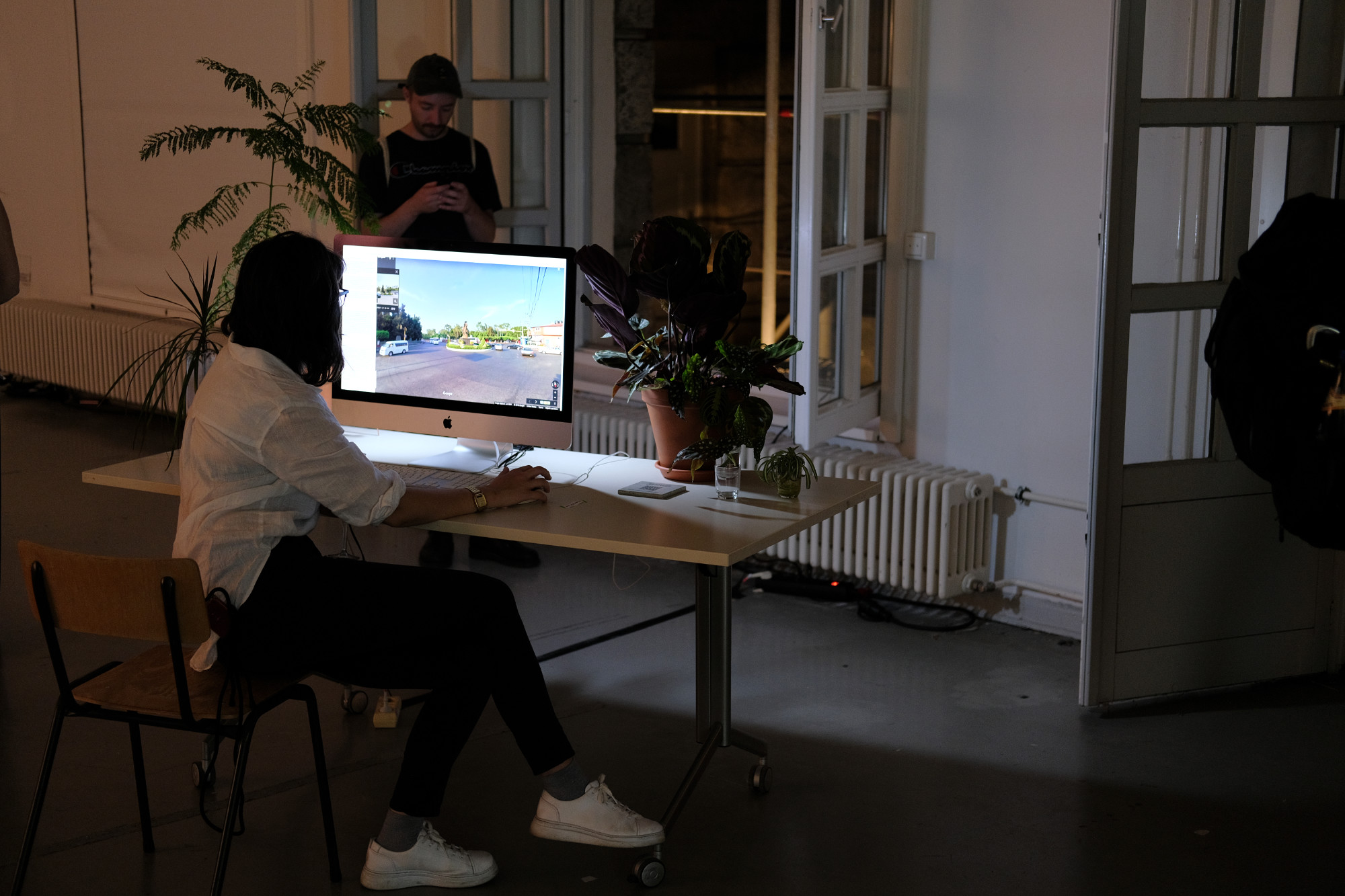THE INHABITANTS
micro and macro
What a map represents is almost always fixed, sturdy and unlikely to move in the following decades. It is static and seems to be neutral or even indifferent to movement. On the other hand it is the most important instrument to make movement happen.
How many times did you bump into a stranger while figuring out which way to go, looking at your screen and following the pivoting of the map? How many times did you approach someone to ask the way when getting lost. Did you ever think: “If I look like I know where I’m going, everything will be fine”? All these small human encounters come from maps and movements. Ligia Fernandes wrote about them from the perspective of love. When you zoom out, you bump into the work Spoglie, Studio #5. Which is an attempt to add this second layer of movement. Microscale becomes bigger when it gets tangled, as if the inhabitants were strands of hair, forming knots, forming networks. The last work in this section is one of Yongxuan Zheng. Where the unicity of one Chinese character, meaning mesh, is the beginning for a map-like structure, filled with associations and other Chinese characters.
Is it possible to map human experiences within the frame and system of a map? How can we tell subjective and hyperpersonal experiences through the indifferent map? The work of Valentina Sarmiento Cruz is a possible answer. She tells a story using Google Street view where the images are created as mere registration. She wades through them and reconstructs her own memories of 3 places. At one point the street view captures protesters by accident. It is here that the map and the individual emotion meet. Manu romeiro maps her city and her experience in it through fine line drawings. It is another way to remember and capture the places we love. Fast life uses the geographical map and its factuality as an advantage. Here the map's indifference is almost an advantage. By delineating on it the origins of popular and exotic foods, the impossible distances they have to cross, become clear. It reawakens awareness of things we take for granted. The visual and tactile net that is stretched makes privileges visible. The map here becomes a mirror in which we encounter ourselves.
Another way of intertwining human experience and the map is in astrological maps. The idea that the movement and alignment of stars and planets influences us. Can we use astrology to describe the city? And does the city have a psyche? All these questions are asked in the work of Berfin Alyeşi. She links the astrological reading of the city with the events in the city. In this way a poetic connection is made between micro and macro, between human and map, movement and staticness.
As mentioned, maps are capable of showing the past and present. But how can we see into the future? Is it possible to shape the future on a map?
Future Archeology deals in part with this. In the work, Sui-Hin MAK proposes what will be found of us in the future. What will remain? The result is an audio guide through the city of Hong Kong, with possible elements.
How many times did you bump into a stranger while figuring out which way to go, looking at your screen and following the pivoting of the map? How many times did you approach someone to ask the way when getting lost. Did you ever think: “If I look like I know where I’m going, everything will be fine”? All these small human encounters come from maps and movements. Ligia Fernandes wrote about them from the perspective of love. When you zoom out, you bump into the work Spoglie, Studio #5. Which is an attempt to add this second layer of movement. Microscale becomes bigger when it gets tangled, as if the inhabitants were strands of hair, forming knots, forming networks. The last work in this section is one of Yongxuan Zheng. Where the unicity of one Chinese character, meaning mesh, is the beginning for a map-like structure, filled with associations and other Chinese characters.
Is it possible to map human experiences within the frame and system of a map? How can we tell subjective and hyperpersonal experiences through the indifferent map? The work of Valentina Sarmiento Cruz is a possible answer. She tells a story using Google Street view where the images are created as mere registration. She wades through them and reconstructs her own memories of 3 places. At one point the street view captures protesters by accident. It is here that the map and the individual emotion meet. Manu romeiro maps her city and her experience in it through fine line drawings. It is another way to remember and capture the places we love. Fast life uses the geographical map and its factuality as an advantage. Here the map's indifference is almost an advantage. By delineating on it the origins of popular and exotic foods, the impossible distances they have to cross, become clear. It reawakens awareness of things we take for granted. The visual and tactile net that is stretched makes privileges visible. The map here becomes a mirror in which we encounter ourselves.
Another way of intertwining human experience and the map is in astrological maps. The idea that the movement and alignment of stars and planets influences us. Can we use astrology to describe the city? And does the city have a psyche? All these questions are asked in the work of Berfin Alyeşi. She links the astrological reading of the city with the events in the city. In this way a poetic connection is made between micro and macro, between human and map, movement and staticness.
As mentioned, maps are capable of showing the past and present. But how can we see into the future? Is it possible to shape the future on a map?
Future Archeology deals in part with this. In the work, Sui-Hin MAK proposes what will be found of us in the future. What will remain? The result is an audio guide through the city of Hong Kong, with possible elements.
Spoglie, Studio #5
Artist: Eleonora Gugliotta ︎ ︎
Eleonora Gugliotta was born in 1989 in Sicily (Italy) and graduated from the Brera Academy of Fine Arts in Milan in Contemporary Decoration. In 2017 she collaborated with the Spain pavilion during the Architecture Biennale, in 2018 she was present with a project at MACRO in Rome and in 2019 she won the first prize at the Paratissima Art Fair Turin. In 2022 she organizes and manages exhibitions of her and other artists at her Atelier in Milan, the city in which she is also a teacher of Graphic and Pictorial Disciplines in an Art School. She has participated in various group exhibitions, presenting installations, photographic projects, videos and performances.

In her works, the artist has always preferred the use of natural filaments - be they wool or hair - transforming them into real signs, strokes like those outlined by a pen that draws what the hand orders and the mind decides. Relative to the space of action they are like microelements that become at the same time points of connection and junction as well as visible trails of the movement of man in space. Along with geographical maps, hair is one of the two main elements compared and on which the game of stairs created with the Spoglie series of collages focuses. Over the random signs and shapes of the maps - formed by roads, rivers and coasts - the artist superimposes a tangle of hair that becomes one with the surface, creating new paths. The natural element takes on soft and sinuous shapes, contrasting with the often-angular signs of the maps and symbolically tracing the chaotic flow of man on earth. In a game between micro and macro, organic traces of man are mixed with paths made invisible, but both designed following the typically human nature of transforming the space around oneself.
Yongxuan Zheng is a Nscad's printmaking student. Focus on learning and practising different printmaking techniques, such as screen printing, intaglio, or relief.


As a non-native English speaker, living in Canada is often plagued by language barriers and culture shock. After learning printmaking, I try to use printmaking as my third language, and use my mother tongue, Chinese characters, as materials to express my ideas. This print is the third work of my Chinese character series. The big character in the background means mesh or net in Chinese, and when it is combined with other character to vocabulary, it can derive meanings such as network, connection, association, etc. I use this big character as a skeleton to draw a map of the city and use more small fonts to build it. They are like buildings, vehicles, and people in the city. The contents of these small fonts are related to history and culture.
Mapping a place out of love
Artist: Lígia Fernandes ︎ ︎Lígia Fernandes is a Portuguese visual artist based between Estonia and Portugal, focused on the intersection between visual arts, socially engaged art, and community economies. In her work, she uses drawing and painting as tools to explore cultural universes, ethnographies, and identities, and organizing as a means to create space for sharing, collaboration, and creation

What happens if we map a place out of love?
What does it mean to map a place out of love?
When approaching a new territory, we are aware of our conditions. We might come with some predetermined questions. We might have already heard about the struggles of the place. Also the tensions. Perhaps it is gentrification, police brutality, tensions between social groups and ethnicities, poverty and marginalisation. We heard about these things, and we want to find out more. (...)
What does it mean to map a place out of love?
When approaching a new territory, we are aware of our conditions. We might come with some predetermined questions. We might have already heard about the struggles of the place. Also the tensions. Perhaps it is gentrification, police brutality, tensions between social groups and ethnicities, poverty and marginalisation. We heard about these things, and we want to find out more. (...)
“La eterna primavera”
Artist: Valentina Sarmiento Cruz ︎ ︎ ︎
Valentina Sarmiento Cruz is an independent writer and researcher that seeks multimedia outputs of her work. She is interested in spatial construction and belonging as well as in spaces that fail the urban/rural dichotomy. She developed this project while living in Chicago, U.S.
La eterna primavera is a web-based project that explores the Mexican city of Cuernavaca through the lives of three monuments. Using Google Street View to digitally trace and track her memories, Valentina Sarmiento Cruz articulates a personal account of her hometown. In collaboration with programmer Roberto Hidalgo and considering that the research and creative processes are rooted in Google Maps, the project mimics the mapping platform to think about how we learn about, interact with, and remember space – especially when we have no physical access to it.



